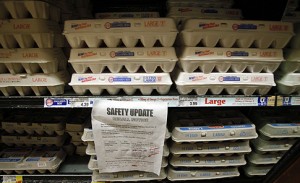Federal investigators have descended on Iowa to try to figure out the cause of a salmonella outbreak that may have sickened thousands of people and led to the recall of a half billion eggs.
Because most of the tainted eggs have either been used or removed from store shelves, consumers at this point appear to have little to fear from eating eggs as long as they are cooked properly. And new safety rules for egg production, which came too late to prevent this episode, might help stave off a similar outbreak in the future.
But some consumer advocates say the huge egg recall highlights a broader and continuing problem at the heart of the nation’s largest food recalls: a highly complicated and often dysfunctional food safety system.
Whether the problems are traced to tainted peanuts, lettuce, tomatoes or frozen hamburger patties, consumer groups say federal oversight too often falls short.
The responsibility for food safety remains split primarily between the Agriculture Department and the Food and Drug Administration. But the way the responsibilities and resources are divided up can seem so illogical that some of the bureaucrats themselves have called for change.
There are few places where that is more evident than in the regulation of eggs. The F.D.A. oversees the safety of eggs still in their shells, but the Agriculture Department regulates liquid eggs that are used in industrial food production, while also being responsible for chickens and the grading of eggs for quality.
Iowa’s agriculture department, meanwhile, said it was responsible for what the farms did with their chicken litter, when spreading it on local fields as fertilizer.
So who inspected the Iowa farms to make sure that the eggs were safe for human consumption? It turns out, no one did.
“F.D.A. has no inspectional history with either of these facilities in Iowa,” said Patricia El-Hinnawy, a spokeswoman for the agency. She said the F.D.A. had traditionally inspected egg farms primarily when they were linked to an outbreak.
But F.D.A. officials and consumer groups say they hope new regulations on egg safety and a proposed new food safety law currently being considered by the Senate will lead to huge improvements.
The crux of the new egg safety rules were devised by scientists nearly two decades ago, but regulators bickered over who should have jurisdiction over the regulatory efforts. In 1999, President Bill Clinton vowed that the F.D.A. would issue new egg regulations and that salmonella in eggs would be eliminated by 2010. But the new rules languished for more than a decade because of internal sniping in the federal bureaucracy and a general deregulatory atmosphere, consumer advocates say.
The regulations finally went into effect last month, too late to stop the current outbreak. The new rules require large egg producers to buy chicks and young hens from suppliers that regularly monitor for salmonella; develop protocols to prevent rodents and pests from spreading disease and conduct testing of poultry houses for salmonella.
“We believe that had these rules been in place at an earlier time it would have very likely enabled us to identify the problems on this farm before this kind of outbreak occurred,” Dr. Margaret Hamburg, the F.D.A. commissioner, said in a media briefing on Monday.
Consumer groups and food safety advocates in Congress also hope the salmonella outbreak provides momentum to a comprehensive food safety bill that has already passed the House but remains stalled in the Senate.

